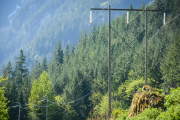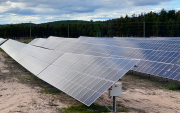At last week's convention of the Union of British Columbia Municipalities, John Yap, B.C.'s Minister of State for Climate Action, announced that the provincial government is developing new offset guidelines to help local governments meet their carbon neutral commitments. While all the details have yet to be hammered out, initial indications are that these guidelines may see substandard offset projects being counted toward carbon neutrality. Now is the time to ensure that these guidelines adhere to the highest possible standards, or we risk losing the integrity of B.C.'s carbon neutral commitment.
How did we get here? In 2007, B.C.'s local governments began committing to the goal of being carbon neutral in their operations by 2012 by signing the Climate Action Charter. The intention of the charter was to encourage signatories, now numbering 179, to reduce their own greenhouse gas emissions as much as possible and then purchase offsets to account for the remainder. The agreement was intended to be an incentive for communities to actually reduce their emissions, because the more local governments reduce their own emissions, the fewer offsets they have to purchase.
While the commitment to carbon neutrality has been a good motivator for some local governments to put climate action on the agenda, the conversation has been sidetracked by offsets: buying them, selling them and re-defining them.
 Let's not forget that the best way to reduce the amount of money spent on energy and offsets is to reduce local government emissions. Reducing local government emissions — by upgrading government buildings or greening vehicle fleets, for example — will provide permanent reductions in the offsets each local government needs to buy. These projects are the surest bet out there to reduce energy bills and offset costs. Of course, some offsets will always be needed if we set our sights on carbon neutrality.
Let's not forget that the best way to reduce the amount of money spent on energy and offsets is to reduce local government emissions. Reducing local government emissions — by upgrading government buildings or greening vehicle fleets, for example — will provide permanent reductions in the offsets each local government needs to buy. These projects are the surest bet out there to reduce energy bills and offset costs. Of course, some offsets will always be needed if we set our sights on carbon neutrality.
Offsets only work if they are held to high standards that ensure that every offset credit represents one tonne of additional, permanent, verifiable greenhouse gas emissions reductions. The provincial government has proposed three options for local governments to invest in offsets. Two of these options, buying offsets from the Pacific Carbon Trust or investing in third-party verified offset projects, will likely meet offset standards. The third option is to invest in a project from a pre-approved list — projects such as curbside composting or energy upgrades — and then to count these emission reductions toward one's carbon neutral commitment. This third option could see local governments counting projects that do not meet high offset standards because the projects would have happened anyway, thereby failing to meet the criteria of additionality.
Allowing sub-standard offsets into the system will result in local governments over-stating their emission reduction achievements. We must not go down this path.
While we need to see more emission reduction projects on the ground in our communities, we can't loosen the standards to make certain projects count as offsets. These projects should be happening anyway, not just because they help reduce greenhouse gas emissions, but because they are good investments in the future of each community. Local governments need support to help make these projects happen, but in many cases, turning projects into offsets will not be the solution.
Through Pembina's work with local governments across the province, we have seen that the commitment to carbon neutrality has made a difference: local governments are thinking about their emissions in a new way and some are taking action to reduce their own emissions. But by making carbon neutrality the goal for local governments, we have also introduced offsets to the conversation. Even though it may not be easy, ensuring that we maintain the highest offset standards will be critical to our success at meaningful climate action. We are now looking to the provincial government to ensure the new offset guidelines meet these standards.






